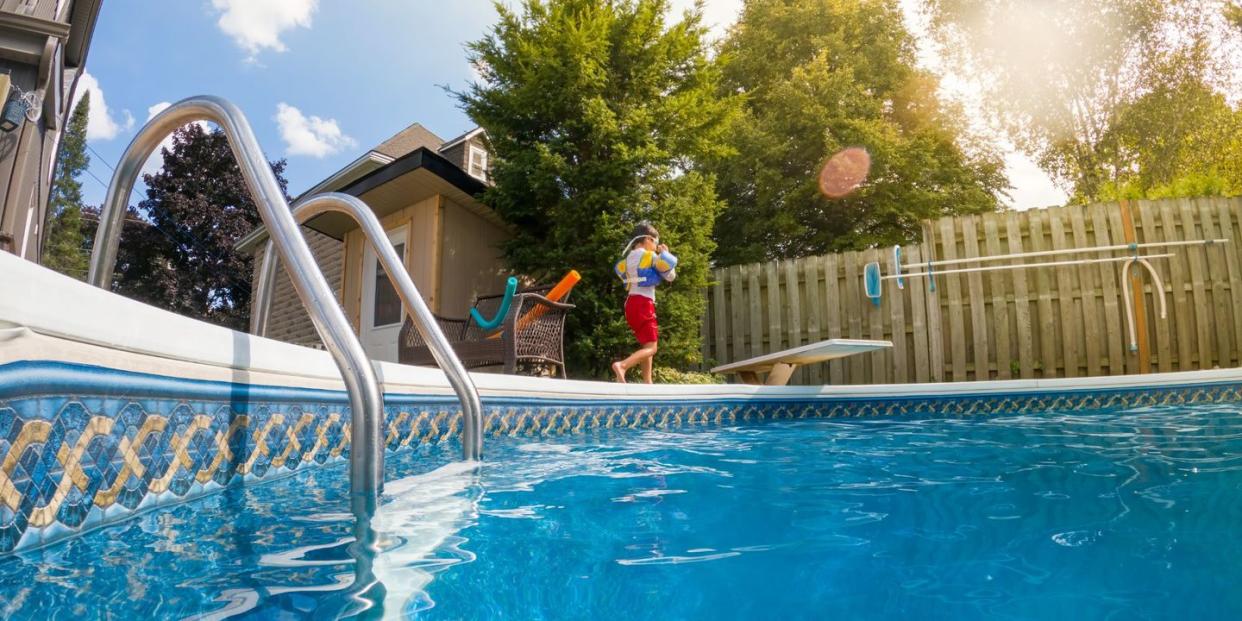How Can You Tell That a Public Pool Is Safe To Swim In?

"Hearst Magazines and Yahoo may earn commission or revenue on some items through these links."
Taking a dip at a hotel, club, gym, or other public pool is a summertime rite of passage. But in the minute before you hit the water, you might find yourself wondering how clean your local pool is (or isn 't).
The good news: So long as the pool or hot tub is being maintained according to Centers for Disease Control guidelines, there's no real risk, says microbiologist Jason Tetro, author of The Germ Code and The Germ Files and host of the Super Awesome Science Show podcast. And if you're going to a community pool, there should be regulations and inspections to make sure you're swimming in safe waters.
To be considered safe, the chlorine concentration in a pool should be high enough to control any potential pathogens in the water, Tetro says. This is usually about 1 part per million. "This is quite small but can be incredibly effective at keeping microbes from growing in the water," he points out.
(Those who have home pools can test their chlorine levels with something like Clorox's Multi-Use Smart Strips.)
The bad news: If there's not enough chlorine in the water, environmental bacteria such as Pseudomonas aeruginosa can grow on surfaces and in the filters, Tetro explains. This bacteria is known for causing itch, red hot tub rash, and swimmer's ear, an outer ear infection that can be itchy and painful and is more common among kids. While these conditions are uncomfortable, the larger concern comes from the bacteria's ability to create microbial communities known as biofilms. These communities allow other pathogens to attach and grow. Those can include pathogens found in feces like the bacteria Escherichia coli and Klebsiella, viruses such as norovirus and hepatitis A, and parasites like Cryptosporidium, Tetro explains.
What can you do to keep these scary sounding germs at bay? First, do your part to help maintain pool hygiene. The CDC recommends never swimming if you have diarrhea, checking pool inspection reports, and not swallowing pool water. Tetro adds that you should shower with soap after swimming.
If you're staring down at a pool or hot tub, how can you assess whether the regulations have been followed, and if you should dive right in or not?
The experts identified four major red flags:
You can smell the chlorine. Although it may seem counterintuitive, a strong chemical smell is suspicious, says Jimmie Meece, brand president of America's Swimming Pool Company, a swimming pool cleaning, repair, and renovation franchise system. "When a pool smells of chemicals, it actually needs more chlorine added," Meece says. "The smell happens when chlorine mixes with external contaminants and indicates the need for balancing chemicals."
Those contaminants could be anything that gets mixed into the pool water, Meece says, like lotions, sweat, saliva, or—you guessed it—urine. If all you can smell is chemicals, then there's a chance something unsavory is in the mix.
It looks like a green smoothie. The most obvious sign that a pool is in bad shape is that it looks green, says pool cleaning expert Tracy Ho, who has more than two decades of experience at Kokido, a pool cleaning company that sells robotic pool vacuums. The Hulk-like hue could hint at an algae infestation (which makes for slimy water and blocks visibility) or a bacteria problem.
It's cloudy, with a chance of contamination. Foggy water could also be troublesome because it could mean the pool's chemicals, including chlorine, are out of whack, or there's a filter that’s backed up, Ho explains.
The hot tub looks extra bubbly. A lot of foam could also spell trouble. (Was it Shakespeare or a hot tub repair man who wrote, "bubble, bubble, toil and trouble"?) Bubbles are normal if the jets are on, but they should quickly dissipate once the jets are turned off, says Jen Rhodes, founder of hot tub resource Tubtopia.com. Any foam that sticks around is not a good sign, because it could mean the pH balance is off or there are too many products that have made it into the water (think: leave-in hair conditioner, body wash, deodorant, detergent clinging to swimsuits).
Also watch out for any floating residue in hot tubs or accumulating on the sides, Rhodes says. It can be a breeding ground for bacteria.
You Might Also Like

